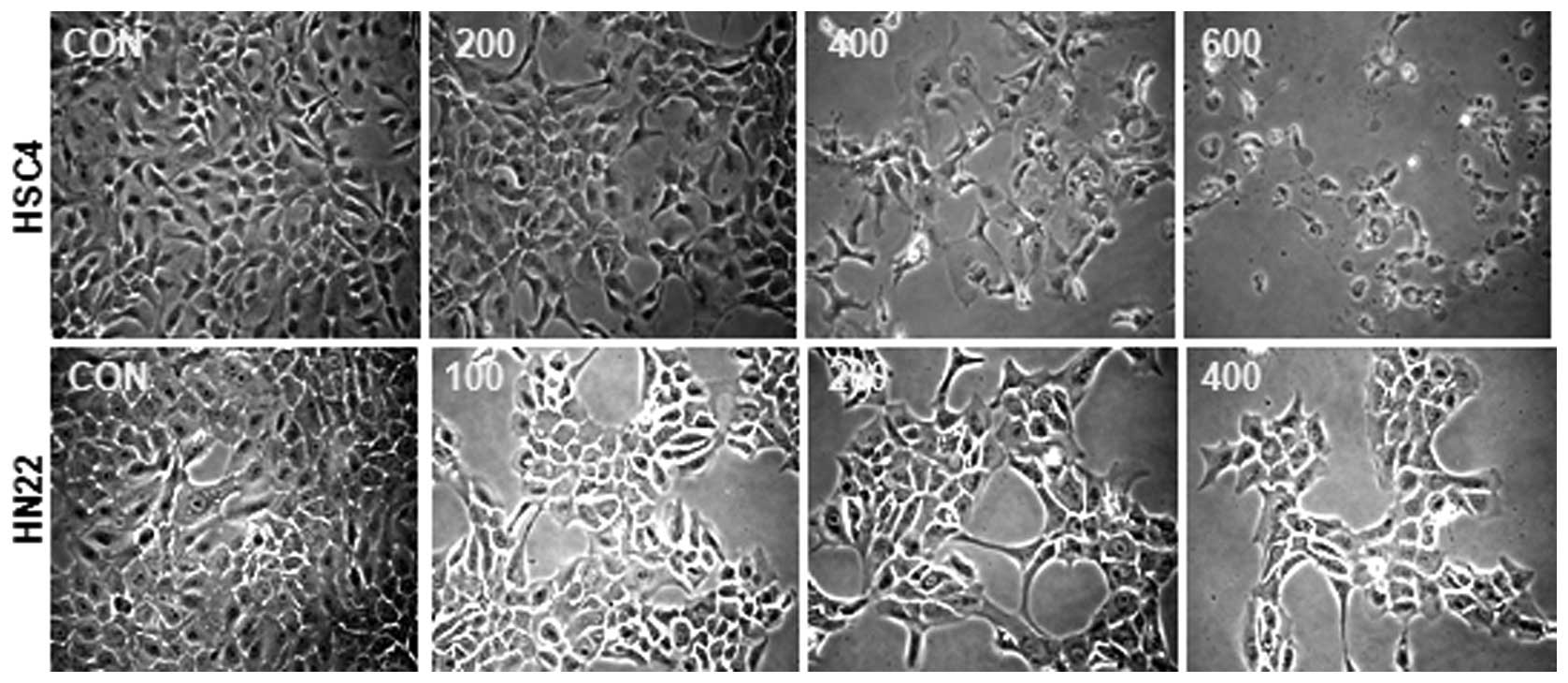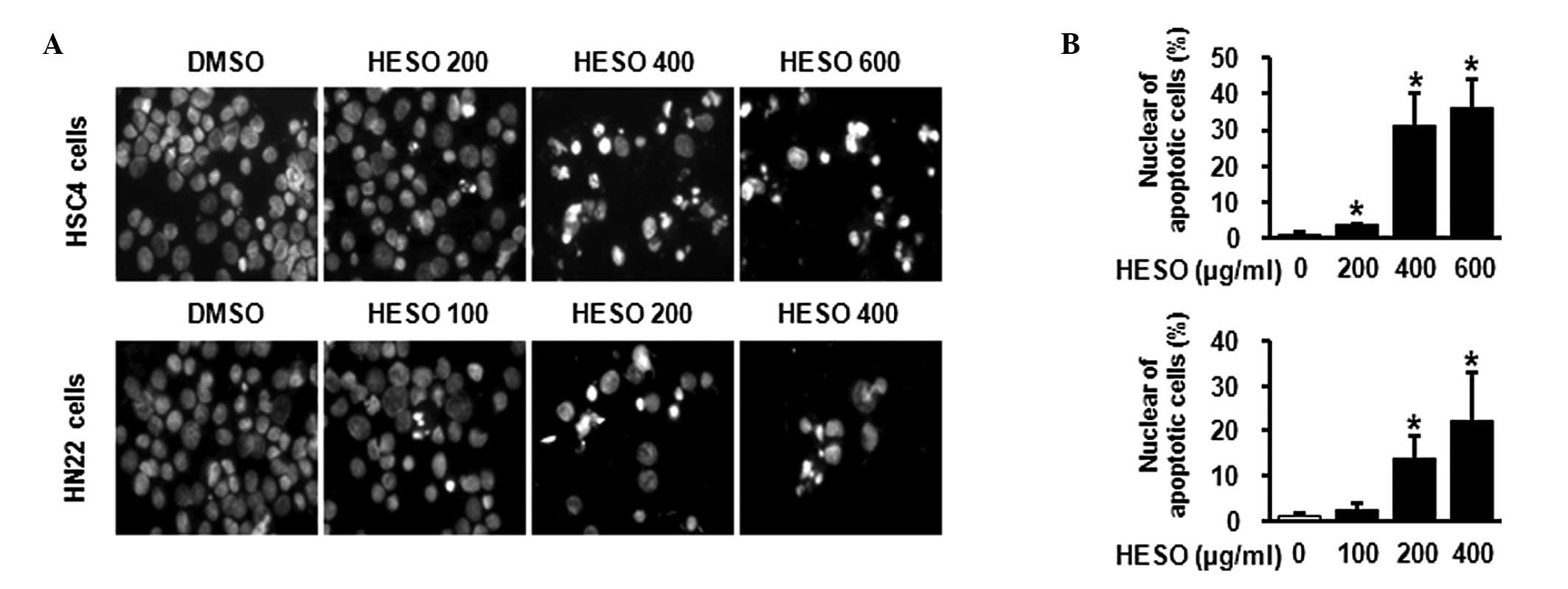|
1
|
Siegel R, Ward E, Brawley O and Jemal A:
Cancer statistics: the impact of eliminating socioeconomic and
racial disparities on premature cancer deaths. CA Cancer J Clin.
61:212–236. 2011. View Article : Google Scholar : PubMed/NCBI
|
|
2
|
Mashberg A, Boffetta P, Winkelman R and
Garfinkel L: Tobacco smoking, alcohol drinking, and cancer of the
oral cavity and oropharynx among U.S. veterans. Cancer.
72:1369–1375. 1993. View Article : Google Scholar : PubMed/NCBI
|
|
3
|
Neville BW and Day TA: Oral cancer and
precancerous lesions. CA Cancer J Clin. 52:195–215. 2002.
View Article : Google Scholar : PubMed/NCBI
|
|
4
|
Michels J, Johnson PW and Packham G:
Mcl-1. Int J Biochem Cell Biol. 37:267–271. 2005. View Article : Google Scholar
|
|
5
|
Liu XS, Jiang J, Jiao XY, Wu YE, Lin JH
and Cai YM: Lycorine induces apoptosis and down-regulation of Mcl-1
in human leukemia cells. Cancer Lett. 274:16–24. 2009. View Article : Google Scholar : PubMed/NCBI
|
|
6
|
Battle TE, Arbiser J and Frank DA: The
natural product honokiol induces caspase-dependent apoptosis in
B-cell chronic lymphocytic leukemia (B-CLL) cells. Blood.
106:690–697. 2005. View Article : Google Scholar : PubMed/NCBI
|
|
7
|
Lee NH, Lee MY, Lee JA, Jung DY, Seo CS,
Kim JH and Shin HK: Anti-asthmatic effect of Sanguisorba
officinalis L. and potential role of heme oxygenase-1 in an
ovalbumin-induced murine asthma model. Int J Mol Med. 26:201–208.
2010.
|
|
8
|
Van Delft MF and Huang DC: How the Bcl-2
family of proteins interact to regulate apoptosis. Cell Res.
16:203–213. 2006.PubMed/NCBI
|
|
9
|
Dash R, Richards JE, Su ZZ, Bhutia SK,
Azab B, Rahmani M, Dasmahapatra G, Yacoub A, Dent P, Dmitriev IP,
et al: Mechanism by which Mcl-1 regulates cancer-specific apoptosis
triggered by mda-7/IL-24, an IL-10-related cytokine. Cancer Res.
70:5034–5045. 2010. View Article : Google Scholar : PubMed/NCBI
|
|
10
|
Okumura K, Huang S and Sinicrope FA:
Induction of Noxa sensitizes human colorectal cancer cells
expressing Mcl-1 to the small-molecule Bcl-2/Bcl-xL inhibitor,
ABT-737. Clin Cancer Res. 14:8132–8142. 2008. View Article : Google Scholar : PubMed/NCBI
|
|
11
|
Chen S, Dai Y, Harada H, Dent P and Grant
S: Mcl-1 down-regulation potentiates ABT-737 lethality by
cooperatively inducing Bak activation and Bax translocation. Cancer
Res. 67:782–791. 2007. View Article : Google Scholar : PubMed/NCBI
|
|
12
|
Lee NH, Lee MY, Lee JA, Jung DY, Seo CS,
Kim JH and Shin HK: Anti-asthmatic effect of Sanguisorba
officinalis L. and potential role of heme oxygenase-1 in an
ovalbumin-induced murine asthma model. Int J Mol Med. 26:201–208.
2010.
|
|
13
|
Shin TY, Lee KB and Kim SH: Anti-allergic
effects of Sanguisorba officinalis on animal models of
allergic reactions. Immunopharmacol Immunotoxicol. 24:455–468.
2002.PubMed/NCBI
|
|
14
|
Yu T, Lee YJ, Yang HM, Han S, Kim JH, Lee
Y, Kim C, Han MH, Kim MY, Lee J and Cho JY: Inhibitory effect of
Sanguisorba officinalis ethanol extract on NO and PGE
production is mediated by suppression of NF-kappaB and AP-1
activation signaling cascade. J Ethnopharmacol. 134:11–17.
2011.
|
|
15
|
Hachiya A, Kobayashi A, Ohuchi A, Kitahara
T and Takema Y: The inhibitory effect of an extract of
Sanguisorba officinalis L. on ultraviolet B-induced
pigmentation via the suppression of endothelin-converting
enzyme-1alpha. Biol Pharm Bull. 24:688–692. 2001.PubMed/NCBI
|
|
16
|
Liu X, Cui Y, Yu Q and Yu B: Triterpenoids
from Sanguisorba officinalis. Phytochemistry. 66:1671–1679.
2005. View Article : Google Scholar : PubMed/NCBI
|
|
17
|
Nijhawan D, Fang M, Traer E, Zhong Q, Gao
W, Du F and Wang X: Elimination of Mcl-1 is required for the
initiation of apoptosis following ultraviolet irradiation. Genes
Dev. 17:1475–1486. 2003. View Article : Google Scholar : PubMed/NCBI
|
|
18
|
Choi KH, Shim JH, Huong LD, Cho NP and Cho
SD: Inhibition of myeloid cell leukemia-1 by tolfenamic acid
induces apoptosis in mucoepidermoid carcinoma. Oral Dis.
17:469–475. 2011. View Article : Google Scholar : PubMed/NCBI
|
|
19
|
Gul O, Basaga H and Kutuk O: Apoptotic
blocks and chemotherapy resistance: strategies to identify Bcl-2
protein signatures. Brief Funct Genomic Proteomic. 7:27–34. 2008.
View Article : Google Scholar : PubMed/NCBI
|
|
20
|
Chetoui N, Sylla K, Gagnon-Houde JV,
Alcaide-Loridan C, Charron D, Al-Daccak R and Aoudjit F:
Down-regulation of mcl-1 by small interfering RNA sensitizes
resistant melanoma cells to fas-mediated apoptosis. Mol Cancer Res.
6:42–52. 2008. View Article : Google Scholar : PubMed/NCBI
|
|
21
|
Ma Y, Cress WD and Haura EB:
Flavopiridol-induced apoptosis is mediated through up-regulation of
E2F1 and repression of Mcl-1. Mol Cancer Ther. 2:73–81.
2003.PubMed/NCBI
|
|
22
|
Gojo I, Zhang B and Fenton RG: The
cyclin-dependent kinase inhibitor flavopiridol induces apoptosis in
multiple myeloma cells through transcriptional repression and
down-regulation of Mcl-1. Clin Cancer Res. 8:3527–3538. 2002.
|
|
23
|
MacCallum DE, Melville J, Frame S, Watt K,
Anderson S, Gianella-Borradori A, Lane DP and Green SR: Seliciclib
(CYC202, R-Roscovitine) induces cell death in multiple myeloma
cells by inhibition of RNA polymerase II-dependent transcription
and down-regulation of Mcl-1. Cancer Res. 65:5399–5407. 2005.
View Article : Google Scholar : PubMed/NCBI
|
|
24
|
Konopleva M, Contractor R, Tsao T, Samudio
I, Ruvolo PP, Kitada S, Deng X, Zhai D, Shi YX, Sneed T, et al:
Mechanisms of apoptosis sensitivity and resistance to the BH3
mimetic ABT-737 in acute myeloid leukemia. Cancer Cell. 10:375–388.
2006. View Article : Google Scholar : PubMed/NCBI
|
|
25
|
Lin X, Morgan-Lappe S, Huang X, Li L,
Zakula DM, Vernetti LA, Fesik SW and Shen Y: ‘Seed’ analysis of
off-target siRNAs reveals an essential role of Mcl-1 in resistance
to the small-molecule Bcl-2/Bcl-XL inhibitor ABT-737. Oncogene.
26:3972–3979. 2007.
|
|
26
|
Fulda S, Scaffidi C, Susin SA, Krammer PH,
Kroemer G, Peter ME and Debatin KM: Activation of mitochondria and
release of mitochondrial apoptogenic factors by betulinic acid. J
Biol Chem. 273:33942–33948. 1998. View Article : Google Scholar : PubMed/NCBI
|
|
27
|
Li Y, He K, Huang Y, Zheng D, Gao C, Cui L
and Jin YH: Betulin induces mitochondrial cytochrome c release
associated apoptosis in human cancer cells. Mol Carcinog.
49:630–640. 2010.PubMed/NCBI
|
|
28
|
Zong WX, Li C, Hatzivassiliou G, Lindsten
T, Yu QC, Yuan J and Thompson CB: Bax and Bak can localize to the
endoplasmic reticulum to initiate apoptosis. J Cell Biol.
162:59–69. 2003. View Article : Google Scholar : PubMed/NCBI
|
|
29
|
Germain M, Milburn J and Duronio V: MCL-1
inhibits BAX in the absence of MCL-1/BAX Interaction. J Biol Chem.
283:6384–6392. 2008. View Article : Google Scholar : PubMed/NCBI
|
|
30
|
Shankar S and Srivastava RK: Bax and Bak
genes are essential for maximum apoptotic response by curcumin, a
polyphenolic compound and cancer chemopreventive agent derived from
turmeric, Curcuma longa. Carcinogenesis. 28:1277–1286. 2007.
View Article : Google Scholar
|
|
31
|
Labi V, Erlacher M, Kiessling S and
Villunger A: BH3-only proteins in cell death initiation, malignant
disease and anticancer therapy. Cell Death Differ. 13:1325–1338.
2006. View Article : Google Scholar : PubMed/NCBI
|
|
32
|
Leber B, Lin J and Andrews DW: Embedded
together: the life and death consequences of interaction of the
Bcl-2 family with membranes. Apoptosis. 12:897–911. 2007.
View Article : Google Scholar : PubMed/NCBI
|
|
33
|
Upreti M, Chu R, Galitovskaya E, Smart SK
and Chambers TC: Key role for Bak activation and Bak-Bax
interaction in the apoptotic response to vinblastine. Mol Cancer
Ther. 7:2224–2232. 2008. View Article : Google Scholar : PubMed/NCBI
|
|
34
|
Heath-Engel HM and Shore GC: Regulated
targeting of Bax and Bak to intracellular membranes during
apoptosis. Cell Death Differ. 13:1277–1280. 2006. View Article : Google Scholar : PubMed/NCBI
|
|
35
|
Wang L, Wei D, Huang S, Peng Z, Le X, Wu
TT, Yao J, Ajani J and Xie K: Transcription factor Sp1 expression
is a significant predictor of survival in human gastric cancer.
Clin Cancer Res. 9:6371–6380. 2003.PubMed/NCBI
|
|
36
|
Shi Q, Le X, Abbruzzese JL, Peng Z, Qian
CN, Tang H, Xiong Q, Wang B, Li XC and Xie K: Constitutive Sp1
activity is essential for differential constitutive expression of
vascular endothelial growth factor in human pancreatic
adenocarcinoma. Cancer Res. 61:4143–4154. 2001.
|
|
37
|
Shim JH, Shin JA, Jung JY, Choi KH, Choi
ES, Cho NP, Kong G, Ryu MH, Chae JI and Cho SD: Chemopreventive
effect of tolfenamic acid on KB human cervical cancer cells and
tumor xenograft by downregulating specificity protein 1. Eur J
Cancer Prev. 20:102–111. 2011. View Article : Google Scholar : PubMed/NCBI
|
|
38
|
Choi ES, Shim JH, Jung JY, Kim HJ, Choi
KH, Shin JA, Nam JS, Cho NP and Cho SD: Apoptotic effect of
tolfenamic acid in androgen receptor-independent prostate cancer
cell and xenograft tumor through specificity protein 1. Cancer Sci.
102:742–748. 2011. View Article : Google Scholar : PubMed/NCBI
|
|
39
|
Shin JA, Shim JH, Jeon JG, Choi KH, Choi
ES, Cho NP and Cho SD: Apoptotic effect of Polygonum Cuspidatum in
oral cancer cells through the regulation of specificity protein 1.
Oral Dis. 17:162–170. 2011. View Article : Google Scholar : PubMed/NCBI
|
|
40
|
Li F and Altieri DC: Transcriptional
analysis of human survivin gene expression. Biochem J. 344(Pt 2):
305–311. 1999. View Article : Google Scholar
|
|
41
|
Chun JY, Hu Y, Pinder E, Wu J, Li F and
Gao AC: Selenium inhibition of survivin expression by preventing
Sp1 binding to its promoter. Mol Cancer Ther. 6:2572–2580. 2007.
View Article : Google Scholar : PubMed/NCBI
|














